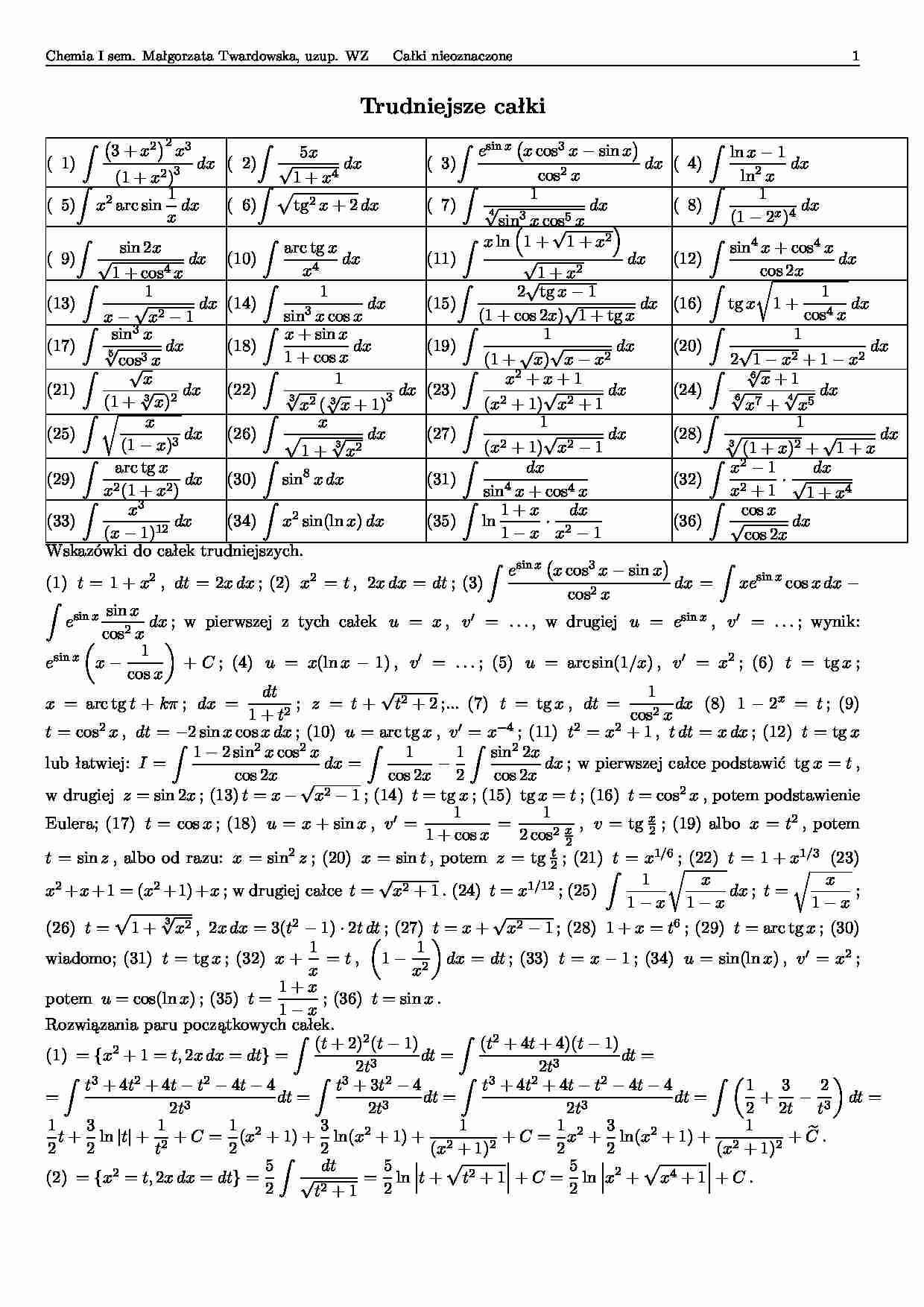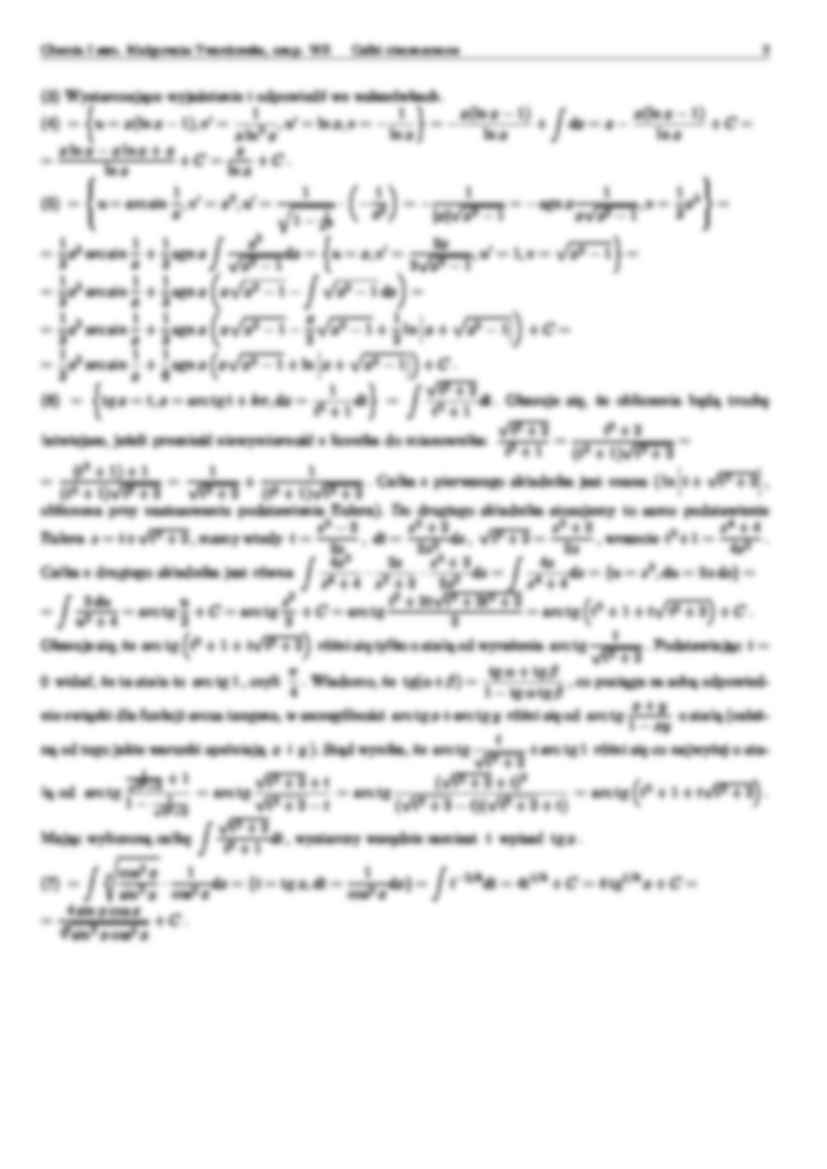To tylko jedna z 2 stron tej notatki. Zaloguj się aby zobaczyć ten dokument.
Zobacz
całą notatkę


Chemia I sem. Małgorzata Twardowska, uzup. WZ
Całki nieoznaczone
1
Trudniejsze całki
3 + x2
( 1)
( 5)
(1 +
2
2
x3
x2 )3
x arc sin
dx ( 2)
1
dx
x
( 6)
√
5x
dx
1 + x4
( 3)
tg2 x + 2 dx
( 7)
sin 2x
arc tg x
dx
(11)
dx (10)
4x
x4
1 + cos
1
1
√
dx
(13)
dx (14)
(15)
3
sin x cos x
x − x2 − 1
sin3 x
x + sin x
√
dx
(17)
(18)
dx
(19)
5
1 + cos x
cos3 x
√
x
1
√ 2 dx
√
(21)
(22)
√
3
3
3 dx (23)
(1 + x)
x2 ( 3 x + 1)
x
x
dx (26)
(25)
(27)
√ dx
3
3
(1 − x)
1 + x2
arc tg x
(29)
dx (30)
sin8 x dx
(31)
x2 (1 + x2 )
x3
dx
(33)
(34)
x2 sin(ln x) dx
(35)
(x − 1)12
Wskazówki do całek trudniejszych.
( 9)
√
esin x x cos3 x − sin x
dx
cos2 x
1
√
dx
4
3
sin x cos5 x
√
x ln 1 + 1 + x2
√
dx
2
√1 + x
2 tg x − 1
√
dx
(1 + cos 2x) 1 + tg x
1
dx
√ √
(1 + x) x − x2
x2 + x + 1
√
dx
(x2 + 1) x2 + 1
1
√
dx
(x2 + 1) x2 − 1
dx
sin4 x + cos4 x
dx
1+x
· 2
ln
1−x x −1
(1) t = 1 + x2 , dt = 2x dx ; (2) x2 = t , 2x dx = dt ; (3)
( 4)
( 8)
(12)
(16)
(20)
(24)
(28)
(32)
(36)
esin x x cos3 x − sin x
dx =
cos2 x
ln x − 1
dx
ln2 x
1
dx
(1 − 2x )4
sin4 x + cos4 x
dx
cos 2x
1
tg x 1 +
dx
cos4 x
1
√
dx
2 + 1 − x2
2 √−x
1
6
x+1
√ dx
√
4
6
x7 + x5
1
dx
√
3
(1 + x)2 + 1 + x
x2 − 1
dx
·√
x2 + 1
1 + x4
cos x
√
dx
cos 2x
xesin x cos x dx −
sin x
dx ; w pierwszej z tych całek u = x , v = . . . , w drugiej u = esin x , v = . . . ; wynik:
cos2 x
1
esin x x −
+ C ; (4) u = x(ln x − 1) , v = . . . ; (5) u = arc sin(1/x) , v = x2 ; (6) t = tg x ;
cos x
√
1
dt
x = arc tg t + kπ ; dx =
; z = t + t2 + 2 ;... (7) t = tg x , dt =
dx (8) 1 − 2x = t ; (9)
1 + t2
cos2 x
t = cos2 x , dt = −2 sin x cos x dx ; (10) u = arc tg x , v = x−4 ; (11) t2 = x2 + 1 , t dt = x dx ; (12) t = tg x
1 − 2 sin2 x cos2 x
1
1
sin2 2x
lub łatwiej: I =
dx =
−
dx ; w pierwszej całce podstawić tg x = t ,
cos 2x √
cos 2x 2
cos 2x
w drugiej z = sin 2x ; (13) t = x − x2 − 1 ; (14) t = tg x ; (15) tg x = t ; (16) t = cos2 x , potem podstawienie
1
1
Eulera; (17) t = cos x ; (18) u = x + sin x , v =
=
, v = tg x ; (19) albo x = t2 , potem
2
1 + cos x
2 cos2 x
2
t
2
t = sin z , albo od razu: x = sin z ; (20) x = sin t , potem z = tg 2 ; (21) t = x1/6 ; (22) t = 1 + x1/3 (23)
√
1
x
x
x2 + x + 1 = (x2 + 1) + x ; w drugiej całce t = x2 + 1 . (24) t = x1/12 ; (25)
dx ; t =
;
1−x 1−x
1−x
√
√
3
(26) t = 1 + x2 , 2x dx = 3(t2 − 1) · 2t dt ; (27) t = x + x2 − 1 ; (28) 1 + x = t6 ; (29) t = arc tg x ; (30)
1
1
wiadomo; (31) t = tg x ; (32) x + = t , 1 − 2 dx = dt ; (33) t = x − 1 ; (34) u = sin(ln x) , v = x2 ;
x
x
1+x
potem u = cos(ln x) ; (35) t =
; (36) t = sin x .
1−x
Rozwiązania paru początkowych całek.
(t + 2)2 (t − 1)
(t2 + 4t + 4)(t − 1)
(1) = {x2 + 1 = t, 2x dx = dt} =
dt =
dt =
2t3
2t3
t3 + 4t2 + 4t − t2 − 4t − 4
t3 + 3t2 − 4
t3 + 4t2 + 4t − t2 − 4t − 4
3
2
1
=
dt =
dt =
dt =
+
− 3 dt =
3
3
3
2t
2t
2t
2 2t t
3
1
3
1
1
1
1 2
1 2 3
2
2
t + ln |t| + 2 + C = (x + 1) + ln(x + 1) + 2
+ C = x + ln(x + 1) + 2
+C.
2
2
t
2
2
(x + 1)2
2
2
(x + 1)2
5
dt
5
5
√
(2) = {x2 = t, 2x dx = dt} =
= ln t + t2 + 1 + C = ln x2 + x4 + 1 + C .
... zobacz całą notatkę




Komentarze użytkowników (0)